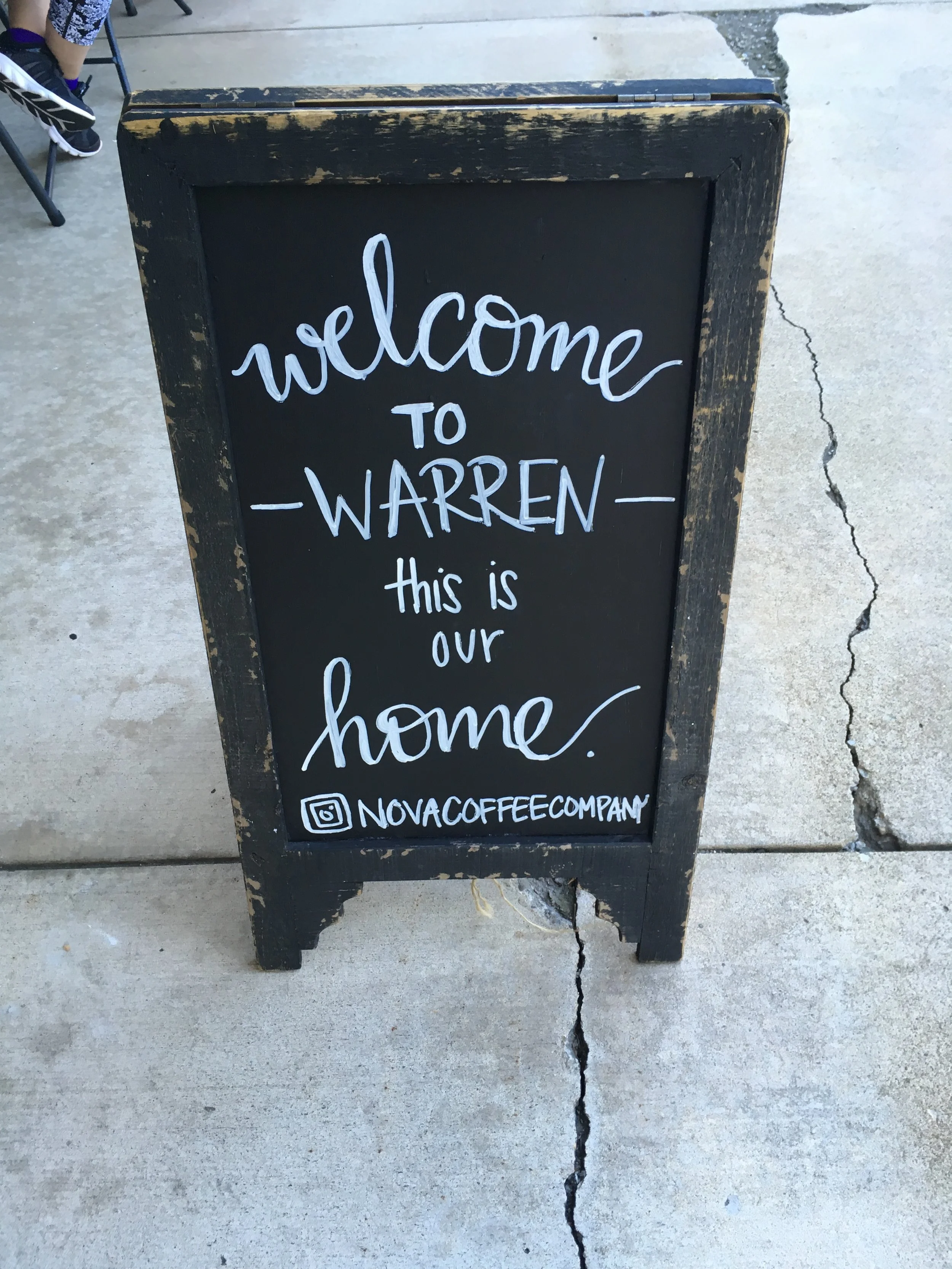Taking a look at what census and housing trends over the past decade show about the state of Youngtown, Ohio.
GOPC Presents at Eastgate Council of Governments Annual Meeting in Youngstown
Hollingsworth presented on GOPC’s research into revitalization opportunities for Ohio’s older industrial cities with smaller populations – like Youngstown and Warren. She focused in on two factors that GOPC’s research has shown makes the biggest difference for revitalization in these places: strong civic infrastructure and quality of place.
GOPC On the Road: Warren & Youngstown
YNDC’s New Small Business Loans
By Octavious Singleton, GOPC Intern

The Youngstown Neighborhood and Development Corporation (YNDC) is promoting growth in Youngstown, Ohio by supporting local businesses. The non-profit will grant equipment loans ranging from $1,000 to $10,000 to companies whose applications are approved. While any type of business can apply, the criteria they must meet include: 1) the company must be located in the city, 2) the owner must be a resident, and 3) the company must have five or fewer employees. To further narrow the selection of businesses, YNDC will consider whether the owners are low-income individuals, if they are hiring, and the likelihood that the business will prosper in the future.
The loan allows the companies the opportunity to obtain needed equipment for business expansion, which should ultimately generate economic benefits in the city. YNDC is only attaching a 2% interest rate to the loans. The YNDC will also be flexible on the amount of years repayment will take. This approach is set up to ensure small companies benefit from the aid.
Selected companies will be awarded loans in November. The loans will be a pilot program to determine whether YNDC expands its mission into micro-business support. Loan applications are available in YNDC office, at 820 Canfield Road, and by emailing Liberty Merrill at lmerrill@yndc.org.
For more information on this program, visit YNDC’s website.
See also: “YNDC Taking Applications for Small Business Loans” by Josh Medore for The Business Journal
GOPC Travels to Youngstown
Yesterday, GOPC's Lavea Brachman and Marianne Eppig traveled to Youngstown to meet with some of the organizations and people working to revitalize the inner city. Since we were last there, things have been consistently improving. People are excited about the downtown. Businesses and institutions are opening their doors in gorgeous historic buildings. A renewed sense of energy and purpose abounds. Here are some of the photos we took along the way, showing a beautiful city:
We look forward to returning to Youngstown soon!
GOPC Presents the Commercial Vacant Properties Guidebook in Youngstown
By Marianne Eppig, Manager of Research & Communications
On Monday, I traveled to Youngstown to introduce our new guidebook for redeveloping commercial vacant properties at the Strong Cities, Strong Communities (SC2) Bootcamp hosted by the German Marshall Fund of the U.S. The SC2 Bootcamp in Youngstown was a two-day workshop that brought together national experts and local stakeholders to exchange ideas in support of economic and community revitalization in downtown Youngstown and the surrounding region.
The panel I participated in focused on “Tools and Strategies for Revitalization” that can be used as part of a holistic approach to redevelopment in Youngstown. Tamar Shapiro of Center for Community Progress moderated the panel expertly and the other (highly esteemed) panelists included Georgetown University Professor and Streetsense Director of Research and Analysis Heather Arnold, Jamie Schriner-Hooper of the Community Economic Development Association of Michigan, and Terry Schwarz of the Cleveland Urban Design Collaborative.
For my presentation, I introduced GOPC’s new guidebook for redeveloping commercial properties, titled Redeveloping Commercial Vacant Properties in Legacy Cities: A Guidebook to Linking Property Reuse and Economic Revitalization. Local leaders and practitioners--such as those from community development organizations, municipal planning and economic development departments, Main Street and commercial district programs, SIDs and BIDs--can use the guidebook to plan and manage the revitalization and reuse of commercial vacant properties in legacy cities. The guidebook includes the following tools:
- Guidance on planning & partnering for commercial revitalization
- Methods for analyzing the market
- Advice on matching market types & strategies for commercial revitalization
- Legal tools for reclaiming commercial vacant properties
- Funding sources for overcoming financial gaps
- Menu of property reuse options
- Ways to attract & retain business tenants
- Methods and models for managing a commercial district
- Strategies for building markets in legacy cities
GOPC produced this guidebook in partnership with the German Marshall Fund of the U.S. and the Center for Community Progress. We plan to release the guidebook within the next month.
Click here to view my presentation on the commercial vacant properties guidebook.
The panel also covered tools for developing vibrant retail streets (see Streetsense’s Vibrant Streets Toolkit), methods for working with anchor institutions to revive vacant land and urban spaces (see CUDC’s Pop Up City initiative and Reimagining a More Sustainable Cleveland), and temporary uses for vacant properties (see VACANT Lansing – the event themes are secret until you show up!). Following the panel, we were able to speak with participants and go into more depth on the tools and strategies presented.
Several of us went on a tour of Youngstown after the event. Dominic Marchionda of NYO Property Group showed us around downtown Youngstown and Wick Park. This tour of the city and its surrounding neighborhoods revealed both challenges and opportunities for efforts that are bringing vibrancy to the city. As Terry Schwarz mentioned during our panel, this will be the work of our lifetimes.
Greater Ohio Featured in Youngstown Workshop
 Expert panel (from left): Alan Mallach, Brookings Institution; Lavea Brachman, Greater Ohio Policy Center; Thorsten Wiechmann, TUD professor; and Ian Beniston, YNDC.
Expert panel (from left): Alan Mallach, Brookings Institution; Lavea Brachman, Greater Ohio Policy Center; Thorsten Wiechmann, TUD professor; and Ian Beniston, YNDC.
On March 28th, Greater Ohio Executive Director, Lavea Brachman, traveled to Youngstown, Ohio for the workshop “Policies and Strategies in Shrinking Cities: The Case of Youngstown, Ohio,” hosted by the Youngstown Neighborhood Development Corporation (YNDC) , German Marshall Fund (GMF) and Technical University of Dortmund, Germany (TUD). The workshop included site visits, an expert panel in which Brachman participated, and a presentation by the urban planning students of TUD on ideas for the regeneration of Youngstown’s riverfront and neighborhoods.
The Business Journal cited Lavea Brachman:
Lavea Brachman, executive director of the Greater Ohio Policy Center, said the city is pursuing the right course in its neighborhoods through organizations such as the Youngstown Neighborhood Development Corp., targeting those areas that stand the best chance of turning around in the near-term.
"It's important to look at our redevelopment strategy," Brachman said. "One of the things we're talking about is a master plan for certain key neighborhoods, such as Wick Park, that provides a plan for the future and some comfort for investors."
Much of the redevelopment in the Ruhr Valley, Brachman noted, emphasizes the region's industrial heritage while at the same time brings to life new cultural amenities. "They used these old coal and mining facilities and they're now beautiful cultural designations."
It's an example from which cities such as Youngstown can benefit.
"That goes back to building on our assets," Brachman said, citing a tour of industrial sites she took just that morning. "They have fantastic beauty, and Youngstown should be capitalizing on that."
The following articles cover the workshop:
Vindy: German Students Propose Improvements for Youngstown
WKBN: German Students Offer Revitalization Ideas for Youngstown
Business Journal: German Students Offer Fresh Perspectives on Redevelopment







